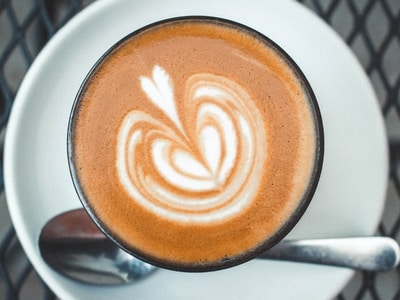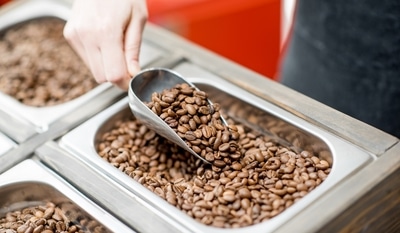What Does Coffee Taste Like? Good vs Bad
Many people love the aroma of coffee but can’t stand its bitter taste. We take a look at why your coffee tastes so bad, and how you can make your coffee taste better.
Good coffee is flavoursome and aromatic with a balance of sweetness and acidity. The flavour and aroma range from chocolate and nut to fruity and floral. Good coffee has a natural sweetness that is complemented by a refreshing acidity. Bitterness is always present in coffee, but it never dominates the cup.
Despite what many believe, coffee isn’t supposed to be bitter. I’m going to show you how to identify and buy delicious coffee.
The taste of good coffee
There are two main types of coffee grown within the coffee bean belt that make up more than 98 percent of all the coffee produced worldwide: arabica and robusta.
Arabica is far superior in taste, and this is what we’re going to concentrate on for our analysis of good coffee.
Arabica coffee contains more than 1000 flavour compounds, which is more than wine. Many of these compounds are created during the roasting process when the raw, green coffee beans are turned into their familiar brown colour.
The roasting process is incredibly important as it can make or break a coffee. Most good-quality arabica coffee is roasted to a light or medium roast profile, which preserves the coffee beans’ natural flavours.
The taste and sensation of coffee can be broken down into the following five categories:
- Flavour and aroma
- Sweetness
- Acidity
- Bitterness
- Mouthfeel
The sign of a good cup of coffee is one that is balanced. No one aspect should dominate the cup to a point that it becomes unpleasant.
1. Arabica flavour and aroma
The flavour and aroma of a coffee is due to its volatile and non-volatile compounds. Some of these compounds are already present in the unroasted coffee beans, and some of them are created during the roasting process.
One of the most famous chemical reactions that takes place during roast is the Maillard reaction.
The Maillard reaction is responsible for the browning of the coffee beans along with the creation of delightful flavours and aromatics. This is the same reaction that takes place when you fry a piece of steak.
These compounds give coffee beans a vast array of flavours and aromatics. They are experienced on the tongue as flavours and in the nasal cavity as aromas.
- Berries: strawberry, blueberry, blackberry, raspberry
- Currants: blackcurrant, redcurrant
- Stone fruit: cherry, plum, peach, apricot, mango
- Dried fruit: raisin, date, prune
- Citrus fruit: pineapple, grapefruit, orange, lemon
- Other fruit: apple, pear, grape, papaya, melon
- Floral: jasmine, lavender, bergamot, rose, chamomile
- Brown sugar: caramel, molasses, honey
- Cocoa: dark chocolate, milk chocolate
- Nutty: almond, hazelnut, peanut
- Spice: clove, cinnamon, nutmeg, pepper, liquorice
Let’s now take a look at the taste of coffee. The taste of a coffee is very different to the flavours and aromas.
Taste is the sense that we detect on our tongue: sweet, sour, bitter, salty and savoury. We are not able to smell these senses.
2. Arabica sweetness
Between 6 – 9 percent of an arabica coffee bean is sugar. The natural sugars levels found in arabica coffee contribute enough of a sweetness that it’s not necessary to add sugar. But why is coffee sweet?
Coffee beans are actually seeds. They’re the seeds that are inside the coffee cherry, which is the fruit of the coffee plant.
Because they’re a fruit, coffee cherries contain sugar. As the coffee cherry fruit ripens, the sugar imparts a sweetness to the beans.
For the best-tasting coffee beans, it’s vitally important that the coffee cherries are allowed to fully ripen. This is something that’s true of any fruit.
Harvesting under-ripe cherries produces a cup of coffee that lacks sweetness. For this reason, coffee has to be meticulously processed if it’s to taste sweet.
3. Arabica acidity
Most arabica coffees have a notable acidity. Acidity is as important in coffee as it is in wine. It creates a refreshing quality that balances the sweetness and bitterness.
There are three different types of acidity found in good arabica coffee:
- Malic acid: the juicy and sharp acidity like that of a green apple.
- Citric acid: the biting acidity like that of a lemon or orange.
- Tartaric acid: the acidity that is found in grapes.
The acidity in arabica coffee is mainly down to having been grown at high altitudes, generally from 1000 – 2000m (3300 – 6600ft) above sea level.
The fact that Brazilian coffee is grown at lower altitudes is why it has lower levels of acidity compared to most other arabica coffee-producing countries such as Colombia.
It’s important to note that acidity is not the same as sourness. Sourness is unpleasant, and it’s something you will have noticed whenever you’ve eaten an under-ripe piece of fruit.
Acidity, on the other hand, brings a delightful quality to foodstuffs. Think of how a piece of pineapple tastes with its perfect balance of sweetness and refreshing, juicy acidity.
4. Arabica bitterness
This is the one you’ve been waiting for. Most coffee is overwhelmingly bitter, which is why it has you reaching for the sugar tin. But coffee isn’t supposed to be bitter.
All coffee has certain levels of bitterness as it’s an inevitable part of the roasting process. However, good arabica coffee that is lightly roasted isn’t noticeably bitter. The traces of bitterness are also balanced out by the sweetness and acidity.
Caffeine often takes the blame for the bitterness is coffee, but it actually contributes very little. The real cause of bitterness is down to the variety of coffee and/or how darkly the coffee beans were roasted.
5. Arabica mouthfeel
Another thing that’s vital to mention is how good coffee feels in the mouth. Most people are used to the heavy body of a dark roast coffee, but lightly roasted coffee is very different.
In fact, it’s so different that the body and texture is often described as being more akin to a tea.
Depending on the variety of arabica and where it’s grown, the coffee may have a mouthfeel that’s creamy, viscous, delicate, thin, buttery or syrupy.
The taste of bad coffee
Coffee beans often taste bad for three reasons:
- Poor processing
- Robusta variety
- Dark roasting
1. Poor processing
Just as with cooking, you can’t make something delicious from bad ingredients. The way a coffee is produced and processed has an enormous influence on the quality of the beans.
Because coffee is the second-most traded commodity on earth, more effort goes into its profitability than do efforts to increase its quality, which is a sad truth.
Because the poor pickers on coffee farms are often paid by weight, they pick under-ripe coffee cherries to boost earning. This is just one of the many reasons why your coffee tastes so bad.
2. Robusta variety
The robusta variety of coffee beans makes up some 30 – 40 percent of all the coffee produced worldwide. Unfortunately, it’s what most of the big chains use for their coffee drinks.
The robusta coffee plant is a lot easier to grow as it’s hardier than arabica because of its higher caffeine levels. It also requires less care and produces greater yields, which is excellent for farmers looking to increase their profit margins.
The problem is that most robusta coffee tastes truly awful. It has nothing like the heady flavours and aromas that arabica coffee has. Robusta can be described as:
- Roasted: burnt, toast, tobacco, smoke, ash
- Industrial: rubber, leather, woody, musty, cardboard
These are all the descriptors you’ll hear used to describe robusta coffee. It gets worse, too:
Robusta sweetness
Robusta coffee beans have 3 – 7 percent sugar levels, which is half that of the arabica variety.
Sugar is vitally important, not only to give the coffee a sweetness, but to also balance out the other elements such as acidity and bitterness.
The lack of sweetness is why you definitely have to add sugar to a cup of robusta coffee.
Robusta acidity
Most robusta contains no acidity whatsoever. This is mainly due to the fact that the robusta plant is grown at lower elevations, from sea level to 600m (2000ft).
This makes for a very dull cup of coffee that lacks that all important refreshing bite that leaves you wanting more. If you’re sceptical about the importance of acidity in food and drink, think about this:
The difference in acidity between an apple and a pear. As fruit goes, the two have a fairly similar flavour. However, apples have a sharp and juicy acidity that leaves you salivating. On the other hand, pears have very little acidity, which makes them pretty dull and a lot less exciting to eat.
Robusta bitterness
Robusta contains almost double the number of acidic compounds of arabica that turn bitter when the coffee beans are roasted.
Robusta also has double the levels of caffeine. Although the caffeine levels aren’t much of an influencing factor in arabica coffee, they do contribute quite significantly to the bitterness in robusta, causing around 30 percent of the overall bitterness.
Add to this that robusta has less sugar and oils, and you can see why it’s so bitter. Just as sugar serves to reduce bitterness, so do the oils. It’s why we add olive oil to our vinaigrettes to balance the bitterness found in lettuce.
3. Dark roasting
The roasting process causes the non-bitter tasting chlorogenic acid to turn into bitter-tasting chlorogenic acid lactones when coffee beans are roasted, which is why all coffee has elements of bitterness.
But when coffee is darkly roasted, the bitterness intensifies dramatically as the already bitter chlorogenic acid lactones breakdown further into phenylindanes.
The phenylindanes produce tastes that are harsh and bitter. When a coffee has been darkly roasted, it’s effectively burnt. You wouldn’t go toasting a piece of bread until it’s turned black, so why drink burnt coffee beans?
It gets worse when you dark roast the robusta variety too. Because the variety has more of these acids to begin with, the bitter effect of roasting darkly is increased even more.
So now we’ve identified that you need a well-processed, 100 percent arabica coffee that’s been lightly roasted, the question is: where is the best place to buy great coffee?
Where to buy good coffee
The ideal way to give the coffee that I’ve described here a try is to make a Google search of specialty coffee near me.
Ignore the Google suggested spots as it often gets confused between specialty coffee shops and more mainstream coffee chains. Scroll down in the results and you should see at least one article that advertises the best specialty coffee shops in your area. That’s the link to click.
Most towns and cities now have at least one specialty coffee shop in the neighbourhood, and it’s the perfect way to see what coffee can taste like without committing to buying an entire bag of beans.
Take the opportunity to chat with the barista and ask what coffee beans are on offer at the moment. They may have several different coffees from different countries. Each coffee will have its own characteristics, so choose which sounds to the most inviting.
Whether you go for a milk-based drink or black, it’s all fine. But if you’re normally a fan of milk but you’re feeling bold, give a cup of black filter coffee a try for a true experience of how incredible good coffee can be.
Also, whichever you choose, make sure to try it first without sugar. You’ll immediately notice how the coffee isn’t bitter as you’re normally used to.
If you’d like to find out more about where you can buy the best coffee beans, check out our guide to the best coffee roasters. Each roaster will roast your coffee to order and post straight to your front door wherever you are in the world.






